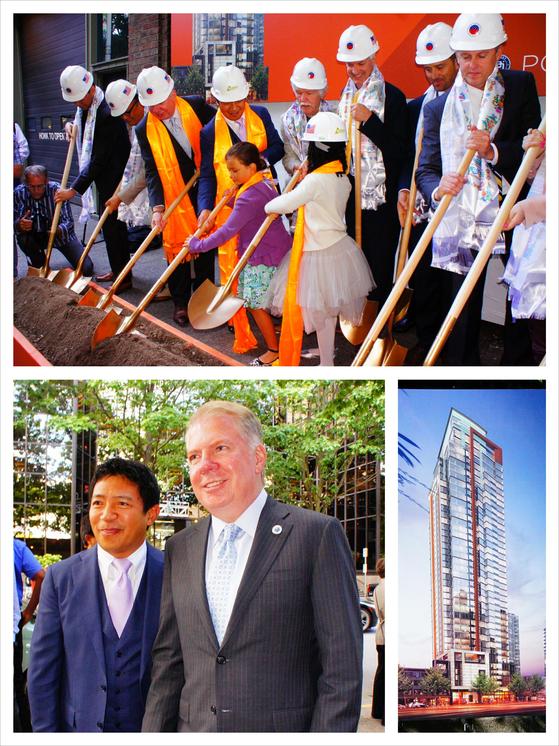Patience, grasshopper. Serenity now. To dust we shall return. Every bromide you can think of applies to the saga of Tibetan-monk-turned real-estate-developer Labsong Dargey. The latest: accusations, from the Securities & Exchange Commission: that he swindled foreign investors out of millions.
On the southeast corner of Fourth Avenue stands the Cinerama movie theater; on the northeast corner is the King County Department of Public Health. In between, a new, 41-story hotel and apartment project that will cost $190 million. A colorful groundbreaking ceremony kicked off construction a year ago this week.
The project, Potala Tower, was named for the Potala Palace in the mountains of Tibet, the former residence of the Dalai Lama. So it made sense that a quartet of Tibetan monks should have chanted prayers and rung temple bells inside the former Dean Transmission shop that was quickly torn down to make way for the tower.
The 41-story building (which may now never be completed) was to include 342 residential units, most of them condos, but some were expected to be market-rate (or even below-market) rentals. The roof deck was to feature include lavish amenities.
Groundbreaking ceremonies featured 14 shovels wielded by political leaders and local celebrities. Mayor Ed Murray, wearing a ceremonial silk khatak, turned the lead shovel; at his side were the developer, Lobsang Dargey and his daughter, Luca; and their mutual friend, the actor Tom Skerritt and his daughter Emi.
The hotel operator of the project, IHG, is the outgrowth of a worldwide chain of prestigious palace hotels, Intercontinental Hotel Group. In Seattle its top property in Seattle is the Crowne Plaza; it also owns all the Holiday Inns. To stay current, over the past decade, IHG has opened 37 "urban boutique" properties, in downtown or mid-town locations, under its new Hotel Indigo brand, encompassing almost 4,500 rooms; there's even one in New York's trendy Chelsea neighborhood. In doing so, IHG took its cue from Starwood Hotels, which found itself stuck with a tired brand, Westin, and remade itself with a brassy new brand called W aimed at younger travelers. The Hotel Indigo planned for Seattle will have 142 rooms, not nearly enough to be a player in the highly competitive convention market, but perfect for upscale leisure travelers. No word on the identity of the hotel's ideally located restaurant.
As it happens, whatever lessons of equanimity that Dargey learned as a monk will serve him well. The State Court of Appeals ruled against his company's waterfront project in Kirkland, an 88-unit development called Potala Village, on Lake Street, that was the subject of fierce opposition. The original plan called for 143 residential units, 316 parking stalls and 6,200 square feet of retail space, which the city of Kirkland found to be out of scale with the neighborhood. Even after Dargey proposed to scale back the project, the city imposed a moratorium on all new construction, a decision upheld by the court. "We're disappointed," Dargey said, "and we're re-evaluating our options."
Dargey had several other projects in the works in addition to the tower in Belltown and the waterfront village in Kirkland. There was a 500-unit project in south Seattle, another in West Seattle, and a market complex in Everett.
Dargey's funding came through a company based in Bellevue called Path America, which facilitates EB-5 visas for foreign investors in American companies. More on that to come. As Seattle.Curbed.com reported today,
Specifically, Dargey is accused of diverting $14 million in foreign investor money from his Seattle and Everett projects to pay for his Kirkland and Shoreline projects. He is also alleged to have pocketed $13 million, some of which was used to buy his home and trips to a casino. Because of the the civil action filed by SEC, a judge has frozen all assets on Potola Tower as well as the Potola Place project in Everett. The ripple effects and fallout of all this could affect not only those projects but multiple other ones from Everett to Seattle to Kirkland.
The EB-5 program was designed to help create jobs, mostly in the building trades, by offering green cards to non-citizens able to pony up a job-creating investment of $500,000. In practice, this benefited wealthy Asians seeking a back door to permanent legal status in the USA. What could possibly go wrong?
